
While it has only been three years since the start of the COVID-19 pandemic, it somehow feels so long ago. Many events have happened that made an impact on society, economics and more importantly, health.
If you’ve had COVID-19 before, you may even experience a decline in your health or some long-term effects. This post-COVID-19 condition is defined by the World Health Organization (WHO) as a condition that happens to those who have a history of probable or confirmed infection of the virus. This usually occurs three months from the onset of COVID-19 and lasts for at least two months. While the condition cannot be explained by an alternative diagnosis, we can make lifestyle changes to get back to our healthy state.
1. Mental health issues
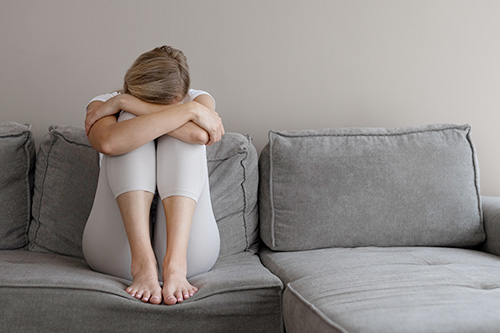 Do you ever feel lonely or hopeless?
Do you ever feel lonely or hopeless?
When you’re stuck indoors, regardless of the amount of time, it can take a toll on your mental wellbeing. At the height of the pandemic, we were all advised to stay home and avoid social interactions—most commonly known as going on quarantine.
Given the order to shelter in place, many of us started experiencing feelings of depression caused by isolation. Even when COVID restriction began to ease up, people continued to socially isolate from high-risk loved ones, and most people kept gatherings in small groups.
People have also increased their anxiety levels due to fear for their health and their loved ones’, as well as financial anxiety due to the economic effects of the pandemic. All these thoughts and feelings make it hard to plan for the future.
According to the Georgetown Behavioral Hospital, those who have quarantine depression experience symptoms that are similar to those of major depressive disorder or other common depression types. One way to tell the difference is if you notice that your depression symptoms occurred at the same time as the pandemic—especially if those feelings centre on feelings of loneliness.
Common symptoms of quarantine depression include:
Despite the fact that the pandemic began more than three years ago, society still experiences health effects related to mental health. In a recent report by KFF, an independent source for health policy research, they explain that concerns about mental health and substance use are still elevated even three years after the onset of the COVID-19 pandemic. In the US, 90% of adults believe that the country is facing a mental health crisis.
A 2022 news story by the World Health Organization shares that the impact of the pandemic on mental health “cannot be made light of.” The organisation shares the following recommendations for response:
Source: The impact of COVID-19 on mental health cannot be made light of
Obesity has been a global issue for many years, and the pandemic may have made this an even bigger concern. According to the Centers for Disease Control and Prevention, obesity in the US was 41.9% in 2017 to March 2020. The percentage significantly increased during the pandemic.
A 2021 survey by the American Psychological Association (APA) has found that around 42% of Americans said they gained more weight than they intended. The poll has found that these people gained an average of 29 pounds.
Experts say that the factors that cause obesity are the following:
These factors, unsurprisingly, are even more rampant during the pandemic.
Arthur C. Evans Jr, PhD, the chief executive officer of the American Psychological Association, says that they have been “concerned throughout this pandemic about the level of prolonged stress, exacerbated by the grief, trauma and isolation that Americans are experiencing. This survey reveals a secondary crisis that is likely to have persistent, serious mental and physical health consequences for years to come.”
“Obesity affects every organ system of the body. It increases the risk of developing high blood pressure, diabetes, high cholesterol, all of which can lead to heart disease and stroke,” says Dr. Steven Hendrick, a Beaumont bariatric surgeon.
“There is an increased risk of developing certain cancers such as breast, cervical, prostate, esophageal and colon cancer as well. People who are morbidly obese on average have a 7-year shorter life expectancy and increases the earlier in life you develop obesity.”
Beaumont Health shares that people suffering from obesity can participate in guided weight loss programs that are usually based on long-term solutions and lifestyle changes.
Moreover, the Centers for Disease Control and Prevention shares their work with partners, states and communities. This is something that can apply to any community to make it easier for everyone to have a healthier lifestyle. States, partners and communities must work together by:
Source: Obesity, Race/Ethnicity, and COVID-19
It was bad enough that we were facing a global pandemic, but things got worse when other infectious diseases emerged and entered the picture, including monkeypox.
Monkeypox is caused by an orthopoxvirus structurally related to the smallpox virus. Those with monkeypox experience a vesicular or pustular rash that is possibly painful.
In May 2022, there were reports of monkeypox from several countries. Most of the cases with travel history reported came from countries in Europe and North America.
In that same month, the World Health Organization received information on a confirmed case of monkeypox in a person who travelled from the United Kingdom to Nigeria and subsequently returned to the United Kingdom.
It started out as a rash on April 29, 2022. This individual arrived in the United Kingdom on May 4. With monkeypox being the suspected case, the individual was isolated immediately.
Thanks to immediate isolation and contact tracing, the risk of onward transmission in the UK is minimal. However, the source in Nigeria is not known.
The two types of monkeypox transmission are a follows:
In the outbreak in 2022, many cases came from transmission during sexual or intimate encounters. This may have come from direct contact with infectious lesions or respiratory secretions.
The World Health Organization shares that public health responds to the UK monkeypox case through the following:
Source: Monkeypox - United Kingdom of Great Britain and Northern Ireland
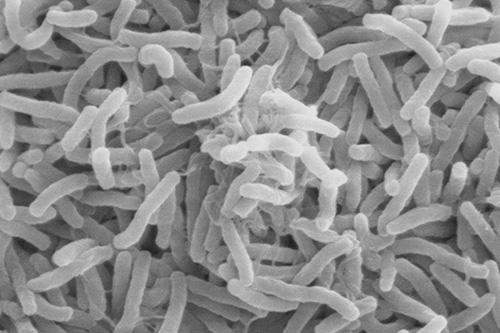
Cholera bacteria
According to EBSCO, cholera is the second most impactful infectious diseases outbreak in 2020—right next to COVID-19. The World Health Organization explains cholera as an acute diarrhoeal infection due to ingestion of food or water that has been contaminated with the bacterium Vibrio cholerae. While the impact of this disease was most severe between 1961 and 1975, it remains to be an annual threat.
A report by the WHO shares that 80 countries reported data on cholera in 2020. Among these 80 countries, 27 reported a total of 323,320 cholera cases and 857 deaths, for a case-fatality rate (CFR) of 0.27%. Excluding Yemen, which accounted for 85% of cases reported globally to WHO for 2020, 47,608 cases and 742 deaths were reported from other countries.
The WHO explains that cholera can be endemic or epidemic. “A cholera-endemic area is an area where confirmed cholera cases were detected during the last 3 years with evidence of local transmission (meaning the cases are not imported from elsewhere). A cholera outbreak/epidemic can occur in both endemic countries and in countries where cholera does not regularly occur,” says the WHO.
The key to controlling cholera and reducing deaths is a multifaceted approach. There must be a combination of surveillance, water, sanitation and hygiene, social mobilisation, treatment and oral cholera vaccines, according to the WHO.
Dengue, a viral infection that comes from mosquitoes, has been widespread since World War II. It’s common throughout Asia and South America, with an average of 390 million infections and 40,000 deaths per year.
EBSCO explains that annual peaks in this infection are not uncommon. In fact, there have been no fewer than 49 separate outbreaks in 2020. The largest was in Brazil with more than 1.3 million reported cases and 500 deaths. Dengue in Brazil is second only to COVID-19.
Symptoms of dengue, if they occur, usually begin 4 to 10 days after infection and last for 2 to 7 days. Symptoms may include:
Source: Dengue and severe dengue
According to the World Health Organization, the incidence of this infection has dramatically grown worldwide in recent decades. Cases reported to the organisation increased from 505,430 in 2000 to 5.2 million in 2019.
Dengue can be avoided by:
Source: Dengue and severe dengue
It’s almost unbelievable that the COVID-19 pandemic only started three years ago. Changes in technology, society and healthcare have occurred, making it feel like the pandemic was so long ago.
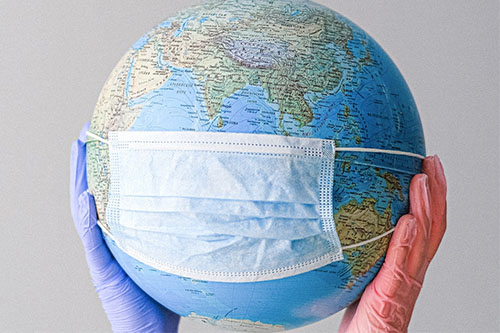
A lot has changed in our world since covid 19
The pandemic has made society shift to a more digital-focused perspective quicker than expected. Classes, meetings, conferences and even full events have been done online in 2020, and some even continue online to this day.
“The pandemic crisis has accelerated the pace of digital transformation, with further expansion in e-commerce and increases in the pace of adoption of telemedicine, videoconferencing, online teaching, and fintech,” says Sergio Rebelo, a professor of international finance at the Kellogg School of Management at Northwestern University.
James Manyika, chairman and director of the McKinsey Global Institute, points out that the world after COVID “is unlikely to return to the world that was.” This is because so many trends that were already in progress in the global economy are being accelerated by the impact of the pandemic.
“This is especially true of the digital economy, with the rise of digital behaviour such as remote working and learning, telemedicine, and delivery services. Other structural changes may also accelerate, including regionalization of supply chains and a further explosion of cross-border data flows,” he says.
One notable thing that can be easily recognised is the way society has shifted its focus on mental health. The Centers for Disease Control and Prevention said that “younger adults, racial/ethnic minorities, essential workers, and unpaid adult caregivers reported having experienced disproportionately worse mental health outcomes, increased substance use and elevated suicidal ideation.”
Incidents like these paved the way for conversations on mental health. “Before the pandemic, many rural Americans and Alabamians did not have access to mental health services due to geography,” says Matthew Macaluso, D.O., clinical director of the UAB Depression and Suicide Center.
“Innovative models for health care delivery relied heavily on virtual visits, and the now widespread use of telehealth has increased access for many patients, which could change the way we provide care in the future.”
As the pandemic prohibited everyone from doing face-to-face activities, children have faced barriers in their education—including a decreased structure and educational disruptions.
“Early childhood students, even the kindergarteners, were figuring out the online platforms while trying to learn the academic content,” says Taajah Witherspoon, Ph.D., associate professor in the UAB School of Education. “The online platform intensified those barriers that we see in the classroom, such as noise levels, and it created unprecedented challenges for teachers and the young learners.”
Despite such barriers, we also acknowledge breakthroughs in education such as new levels of proficiency. Students have become more comfortable with electronic platforms in a classroom setting, and in today’s digital age, this is essential.
The pandemic made us so used to social distancing, avoiding physical contact, and to some, wearing masks. Efforts to protect oneself from others have caused weak social ties that affected communication.
JoLeann Trine, LCPC, a licensed clinical professional counsellor with Thriveworks in Aurora, IL, said: “Arguably one of the largest changes involved social interactions. Suddenly droves of people were working from home, attending class online, and avoiding socialising with anyone outside the household or approved bubble. As people adapted to their new life format, their way of communicating and behaving changed.”
Similar to our point about shifting to digital platforms: The pandemic has caused workers to evaluate and think about what they really want, and this includes thinking about their jobs.
Many workers have realised how remote work can still get the job done, causing them to shift to jobs that have that option.
“Initially implemented because of public health concerns, employees across hundreds of professional fields had a taste of the positive impact that remote work could have in their lives: more time with family, less time spent in the car and improved efficiencies, to name a few high points,” says The University of Alabama at Birmingham.
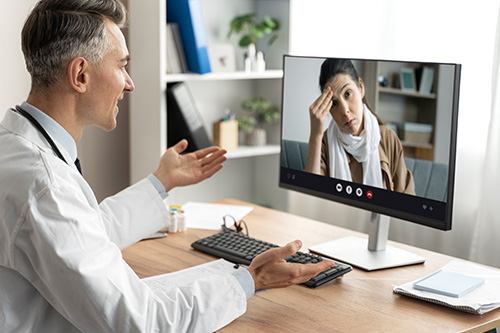
Telemedicine has made it easier for patients to connect with their healthcare providers and get routine care without possibly exposing themselves to COVID-19. The efficiency of telemedicine has made it a staple in many clinics and hospitals to this day.
Doctors from The University of Alabama at Birmingham predict that telehealth will be part of healthcare delivery moving forward and is an essential element for “improved patient outcomes and economic survival of rural hospitals.”
The term “self-care” is nothing new. This term was making the rounds even before the pandemic—but after everything that happened in 2020, it matters to take care of yourself now more than ever.
While we often associate self-care with getting a massage, treating yourself to your favorite dessert or going on vacation, self-care is more than just that.
Taking care of yourself involves being conscious of how you maintain a healthy body—physically, emotionally and mentally. This means eating healthy and getting enough exercise. It means maintaining proper hygiene, cultivating healthy relationships and having leisure time. Simply put, self-care is about the deliberate choices we make.

Self-care involves good sleep quality, maintaining hygiene, etc.
When you lack self-care, you run the risk of medical consequences such as cardiovascular disease, depression, anxiety and obesity.
When you take better care of yourself, you experience reduced stress, improved focus, and compassion for yourself and others.
1. Make healthier choices
This one is a no-brainer, but it helps us to remind ourselves from time to time. Make it a point to eat healthily, get enough sleep and exercise often. It helps to create a routine that involves getting your body moving.
The CDC explains that those who do little or no physical activity have higher chances of getting very sick from COVID-19 than those who are physically active. Regular physical activity leads to better sleep and reduces anxiety. It can also help in preventing weight gain.
2. Know the things you can control
Take control whenever you can. This is especially helpful when dealing with stress, as stress often comes from a sense of uncertainty or lack of control.
Be aware of the things you can control and plan things accordingly to reduce anxious feelings.
If you’ve lost touch with hobbies you enjoy, now is the right time to reconnect. You could also learn a new skill or develop a new hobby.
Making time for the things you love also includes reconnecting with loved ones—either virtually or safely at a distance. This will help you maintain your emotional and mental health.
We all know that the pandemic has made life extra hard—from disrupting schedules to putting peoples’ lives at risk. Understand that you don’t have to be tough all the time. It’s important to acknowledge that things are difficult.
Take a moment to reflect on the changes and sit with your feelings—don’t suppress them. Allow yourself to express grief, anger, sadness or whatever the situation is making you feel.
With more people experiencing anxiety since the pandemic, we are more susceptible to absorbing worries, fears and negativity from other people.
Openly communicate your boundaries—particularly to people in your life who are prone to focus on worst-case scenarios. Protecting your peace does not mean a lack of care towards your loved ones.
Understand that life doesn’t have to be perfect. Set realistic expectations and be kind to yourself even if you don’t meet these expectations to avoid burning out.
While it has been three years, we continue to live in a world where COVID exists.

Exercise helps alleviate tension and stress.
In May 2023, the World Health Organization officially declared the end to the global emergency status for COVID-19. “It is therefore with great hope that I declare COVID-19 over as a global health emergency,” said WHO Director-General Tedros Adhanom Ghebreyesus.
However, this does not mean that COVID no longer exists. “The battle is not over. We still have weaknesses and those weaknesses that we still have in our system will be exposed by this virus or another virus. And it needs to be fixed,” according to the WHO's emergencies director Michael Ryan.
Infectious disease experts point out that the virus will continue to challenge health systems worldwide. With that, we shouldn’t be complacent. We must continue practicing healthy habits as a form of self-care.
2. Do regular physical exercise — We can’t stress this enough: Exercising can do wonders. Regular exercise stimulates the brain to produce feel-good hormones called endorphins. These hormones relieve tension and stress as they enhance both physical and mental energy.
3. Ensure quality sleep — A good night’s sleep helps the brain process information better, maintain good memory and reduce fear. After all, sleeping well at night is like hitting the reset button for our tired brains.
4. Be cautious with information — The pandemic has made it easy for peddlers of fake news to spread a lot of disinformation. But remember: Accuracy of information is more important than the volume of information. Only get your news from trusted sources such as credible news sources, the government or their partner agencies.
5. Be prepared — Like we said, the virus is still out there. Be prepared by having enough masks, alcohol and other disinfectant materials just in case. Keep yourself updated about disease outbreaks and their symptoms.
6. Distract yourself with a hobby or interest — To protect your mental health, go for activities that will help you relax and keep yourself away from worry and anxiety.
7. Maintain relationships — Now that we’re no longer in a global health emergency, we can finally make up for all the years we weren’t able to spend physically with our loved ones.
Read more on our blog “Self-care during a pandemic: protecting those around you starts from caring for yourself”
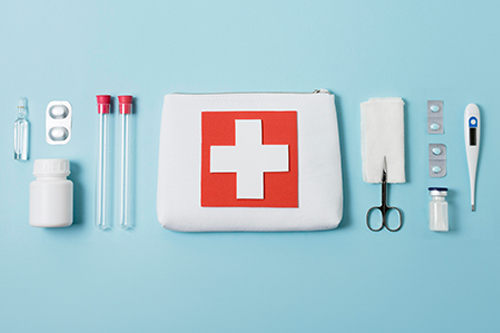
First aid kit
Travelling abroad doesn’t automatically mean you'll end up with an infectious disease. Follow these tips from Johns Hopkins Medicine to reduce the risk:
2. Make sure your vaccines are updated — Prevention is always better than cure, and with all the infectious diseases these days, it’s best to be protected.
3. Have a traveller’s first aid kit — Your traveller’s first aid kit should have items geared to where you’re going. Include some additional supplies that will last a few days past your trip duration. You may reach out to your healthcare provider to identify what you need in your kit.
4. Keep yourself informed about medical care and the medical evacuation services available — This is in case of emergencies or serious illness. Be sure you have medical insurance before you travel, and contact your health insurance plan to know what is covered in other countries.
5. Contact your healthcare provider as necessary — This is for when you notice any symptoms when you get home. While symptoms can include fever, rash, joint pain and diarrhoea, each individual’s symptoms may be different. If you become ill upon coming home, contact your healthcare provider immediately.
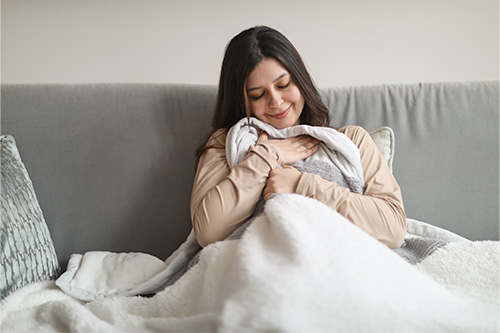
A woman living a happy and healthy lifestyle
Living a healthy and happy life doesn’t mean that life has to be perfect. It simply means knowing how to handle whatever comes your way. Remember: People have different ways of handling stress, and there’s no definite rule on how to go about it. As long as it makes you happy, then go for it.
However, in all that you do, two things should be constant: 1) regular exercise and 2) sufficient sleep. These two things can help you achieve a healthier and happier life.
Exercise
Regular exercise promotes better health and mood in the following ways:
Sleep
Sufficient sleep has the following physical and mental advantages:
To get high-quality sleep, you must have a high-quality sleep environment by:
The sleep your body needs changes as you age. Teens from 14 to 17 years old need eight to ten hours of sleep. Adults from 18 to 64 need around seven to nine hours of sleep. Those older than 65 need around seven to eight hours of sleep.
Read more on our blog “Your Guide to a Healthy and Happy Life”
Nature's Impact on Health & Wellbeing
 Connecting with nature helps reduce stress.
Connecting with nature helps reduce stress.
In the realm of health and wellbeing, we are making an earnest call for individuals to stand up and step away from a sedentary lifestyle, which has been linked to an increased risk of chronic diseases.
Engaging with the great outdoors, such as visiting national parks, can provide an excellent avenue for stress reduction and worry alleviation.
Research has noted that natural sounds like bird songs, running water, and ocean waves can have particularly soothing effects. Furthermore, the positive memories or pleasant feelings generated from such natural interactions can persist for an extended period, according to some studies (source: PubMed Central). If accessing national parks is a challenge, a simple 30-minute stroll in your local park can offer similar benefits.
If regular visits to national parks or beaches are not feasible, or you want to experience the calming influence of nature sounds at any time, products like Wellcare Naturecare Sound Relaxation can help extend your pleasant experiences with nature.
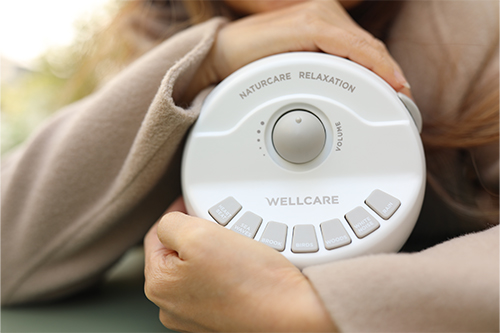
The Naturcare Sound Relaxation product from Wellcare
Read more on our blog “Naturcare Sound Relaxation: Dealing with Tinnitus”
It’s always a good idea to eat healthily. According to the World Health Organization, a healthy diet “protects you against many chronic non-communicable diseases, such as heart disease, diabetes and cancer.” When you’re consuming less salt, sugars and saturated and industrially produced trans fats, you improve your health and nutrition as you give yourself a healthy diet.
Here are the foods we recommend you eat, avoid and add to improve your nutrition:
EAT: Fresh, whole foods
Natural food is always the healthier choice than processed food for obvious reasons. Whole foods are unprocessed and unrefined. The fresher they are, the better. On the other hand, canned and microwavable meals often provide minimal nutrition.
The World Health Organization explains that eating at least 400 g or five portions of fruit and vegetables per day can reduce the risk of noncommunicable diseases (NCDs). It also ensures an adequate daily intake of dietary fibre.
Ways you can improve food and vegetable intake include including vegetables in meals and eating fresh fruits and vegetables as snacks.
EAT: Organic food
Organic food is different from whole foods or natural food. Organic food is all about the products of certain methods of raising livestock and farming.
While the specific characteristics of producing organic food differ depending on the authority awarding the classification for each country, there are some common factors:
They may not be the same as natural food, but organic food has slightly more nutrients than conventionally grown food. Healthline summarises the meaning of organic food as “produced through farming practices that only use natural substances.” Therefore, producing organic food means avoiding all artificial chemicals, hormones, antibiotics and GMOs.
AVOID: Salt, sugar and trans fats
It’s easy to love salty, sugary and fatty food, which means it can be hard to let them go. Don’t worry—you don’t necessarily have to cut them out entirely. Just be sure to consume less of them, mainly because too much sugar or salt increases your risk for chronic diseases. Too much salt raises blood pressure, while refined sugars (sugars that are not naturally present in food) provide few nutrients but a lot of calories.
According to the World Health Organization, reducing salt intake to the recommended level of less than 5 g per day could prevent 1.7 million deaths each year.
You can reduce your salt intake by:
Fast food is commonly known to contain high salt, sugar and trans fat. Trans fat can be found in oils and raises bad (LDL) cholesterol levels, lowers good (HDL) cholesterol levels and increases the risk of heart disease.
ADD: Whole grains, fruits and vegetables

Whole foods play a role in maintaining good health.
When you’re craving your usual unhealthy snacks, try eating alternatives such as whole grains and high-fibre starch. Starchy foods provide important nutrients and contain complex carbohydrates.
The Harvard T.H. Chan School of Public Health explains that “a diet rich in vegetables and fruits can lower blood pressure, reduce the risk of heart disease and stroke, prevent some types of cancer, lower risk of eye and digestive problems, and have a positive effect upon blood sugar, which can help keep appetite in check.”
To maintain a healthy diet, remember to also:
Know how much food you should take. If you eat too little, you impair your growth. If you eat too much, you put a burden on your body. Men are recommended to have around 2,500 calories a day (10,500 kilojoules), while women are recommended to have 2,000 calories a day (8,400 kilojoules).
2. Make it convenient
Whether you notice or not, here’s the truth: Convenience determines our diets. Therefore, you should remember to make healthy options more convenient for you. You can prepare your healthy meals beforehand, put them in accessible areas and encourage the people you eat with to follow similar habits.
3. Practise healthy habits between meals
Eating healthy doesn’t stop during meals—the moments between meals matter too. Be sure to regularly get a full night’s rest to maintain the hormones that keep your appetite in check.
Read more on our blog “8 Top Tips for Healthy Eating”
While working is an essential part of living, there’s no denying that certain indoor spaces and setups are harmful to our health. Cramming many people into a small space is a quick way to cause health hazards.
Some of the ways that your office could be ruining your health include:
Ergonomic risks generally involve the way chairs and desks are built and positioned relative to each other. Aside from the obvious possible accidents that could occur due to poor positioning, other possible health risks include poor posture.
Poorly designed workspaces force workers to have poor posture, which can give you muscle strain and skeletal damage. This is especially true for repetitive manual tasks and prolonged sitting.
Having bad posture can cause the following issues:
You can improve your posture by:
It’s common for some offices to have poor air quality. The air in a commercial building can sometimes be up to 100 times more polluted compared to outdoor air. Granular matter coming from machines like printers can be especially harmful, and air conditioners cycling it through the building make it even worse.
According to the United States Environmental Protection Agency, three major reasons for poor indoor air quality in office buildings are:
Building occupants exposed to poor air quality may experience the following:
3. Poor lighting
Offices can have a combination of little natural light and an excess of artificial light. This includes the glare and blue light that come from computer monitors.
When a person lacks sunlight exposure, they could be at risk of insufficient vitamin absorption and sleep problems.
The International Labour Organization explains that poor lighting in a work environment can possibly lead to eye strain, fatigue, headaches, stress and accidents. Meanwhile, too much light can lead to safety and health problems like “glare” headaches and stress.
According to the Canadian Centre for Occupational Health and Safety, one’s ability to see at work doesn’t only depend on lighting. It also depends on:
4. Bacteria-breeding grounds
Work equipment like desks and keyboards can host large populations of bacteria.
According to DisinfectCARE, calculations have shown that there are “more than 10 million bacteria on one office desk, over 1 million bacteria on a copier start button, and over 100,000 bacteria on a coffee pot handle.” In one day, the average office worker will touch up to 30 different items.
Remember, viruses can survive for two or three days on items like desktops and computer keyboards. These viruses can be transmitted when you touch contaminated objects and then put your hands on parts of your face.
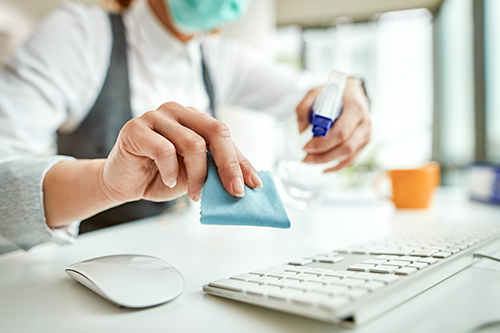
A worker sanitizing her keyboard.
If you work in an office, you can avoid or minimise the risk of contamination by regularly washing and sanitising your hands, improving the office ventilation and disinfecting the office equipment.
Other ways to germ-proof your office are to:
5. Other stressors
Other stressors vary from person to person, but these could be anxiety, poor eating habits or loss of sleep.
Read more on our blog “How Your Office Job Could Be Wrecking Your Health"
Part of living healthily is keeping yourself healthy when you’re in an environment that is naturally detrimental to your health, such as cold weather.
Cold temperature, by definition, is a relatively low temperature compared to that of the human body. However, the word “cold” can differ from person to person. If you’re used to a tropical environment, cold temperatures can be under 10 °C (50 °F). If you’re used to areas in the northern hemisphere, “cold” could mean temperatures as cold as -69.6°C (-93.3°F).
This subjectivity makes it complicated to define “extremely cold weather.” Nonetheless, the fact remains that the earth’s axis is tilted away from the sun during winter. This angles the northern hemisphere farther from solar radiation and leads to winter storms and cold outbreaks, with winds that bring low temperatures from the north pole. With prevailing winds, the atmosphere will circulate throughout the world.
According to Healthline, cold temperatures can lower immunity in the nose, therefore making us more susceptible to viruses. “A drop in nasal tissue temperature of just 5° C reduced immune response by almost half,” Healthline explains.
Cold weather generally impairs the body’s response to protect itself. Since illnesses like colds and flu are more common during winter time, the nasal immune response may be impacted by cold air.
A recent study experimented by exposing nasal tissues to temperatures of 4.4° C (39.9° F). It has been found that doing this led to around a 5° C (9° F) decrease in tissue temperature. This includes major consequences for the immune system.
“This drop significantly reduced this innate immune response in the nose,” said Dr. Benjamin Bleier, director of Otolaryngology Translational Research at Mass. Eye and Ear and co-author of the study published in The Journal of Allergy and Clinical Immunology.
“This reduced response can make the virus more able to both stick to and infect the nasal cells… they can divide and cause infection,” he added.
To strengthen your nasal defences, be sure to get enough vitamin C, regularly wash your hands, wear high-quality masks and cover your mouth when sneezing or coughing.
Read more on our blog “Battling extreme cold weather and keeping yourself healthy” and “A harmonious coexistence between nature and mankind, practicing sustainable happiness”
As several factors of the world changed because of the pandemic, certain trends emerged as well.

Do you have a meal plan?
It is now widely known that health is not a one-size-fits-all concept. Since our bodies are all different, the trend of having personalised wellness experiences has emerged.
For example, meal plan services would have an in-house nutritionist whom you can talk to so you could identify the right meal plan for you. The meal plan service would then curate a menu and prepare meals especially made for your body’s needs.
Since the pandemic has made it difficult to head to gyms, wellness clinics and exercise studios, it has become a trend to own exercise equipment and devices to keep oneself healthy from the comfort of their homes.
Other than exercise equipment, wellness devices have also made their way to the spotlight during the pandemic.
With all the pandemic restrictions, virtual consultations have become the norm. Even now that it’s deemed safe to leave our homes, it’s still common for many to consult their healthcare providers virtually instead.
With all the pandemic has made us realise, the world is slowly removing mental health taboos. Today’s generation is more in tune with their mental health.
According to the World Economic Forum, almost a fifth of Generation Z and 13% of millennials consult a mental health professional at least three times a year.
Read more on our blog “How Health and Wellness Industry Trends May Increase Personal Care Product Demands in 2017” here.
Taking Care of Your Health Naturally
You don’t have to rely on medication to stay healthy. Remember, it’s best to go for lifestyle changes first before being reliant on medication. After all, using too many medications can lead to adverse effects and misdiagnoses. In many cases, you may not even need all the medications.
“Many medications for chronic diseases are focused on reducing the risk of a bad outcome in the future. In studies, we see that there is often a lag time—from months to years—from starting a medication to seeing an actual reduction in the risk of a bad outcome,” says Dr. Gregory Ouellet, MD, MHS, a geriatrician at Yale Medicine’s Dorothy Adler Geriatric Assessment Center.
“If the typical time to see a benefit is longer than a patient’s life expectancy, we may be subjecting them to adverse effects with little chance of benefit.”
There’s also no denying that some drugs can have adverse effects. Certain medications and combinations of medications can affect one’s capacity to think and concentrate. These combinations can also cause confusion, memory loss and delusions.
That being said, we highly recommend natural ways of staying healthy—lifestyle changes such as eating healthily, letting go of vices and exercising regularly.
Check out the video “Natural and non-medicated methods help people have a healthy life!”

Consider making lifestyle changes to thrive in the post-pandemic era.
While the pandemic has left us with ongoing effects on our physical and mental health, certain lifestyle changes and changes in our perspective can do wonders in staying healthy naturally.
Avoid relying on medications; it’s possible to go back to your healthy state by doing simple lifestyle actions.